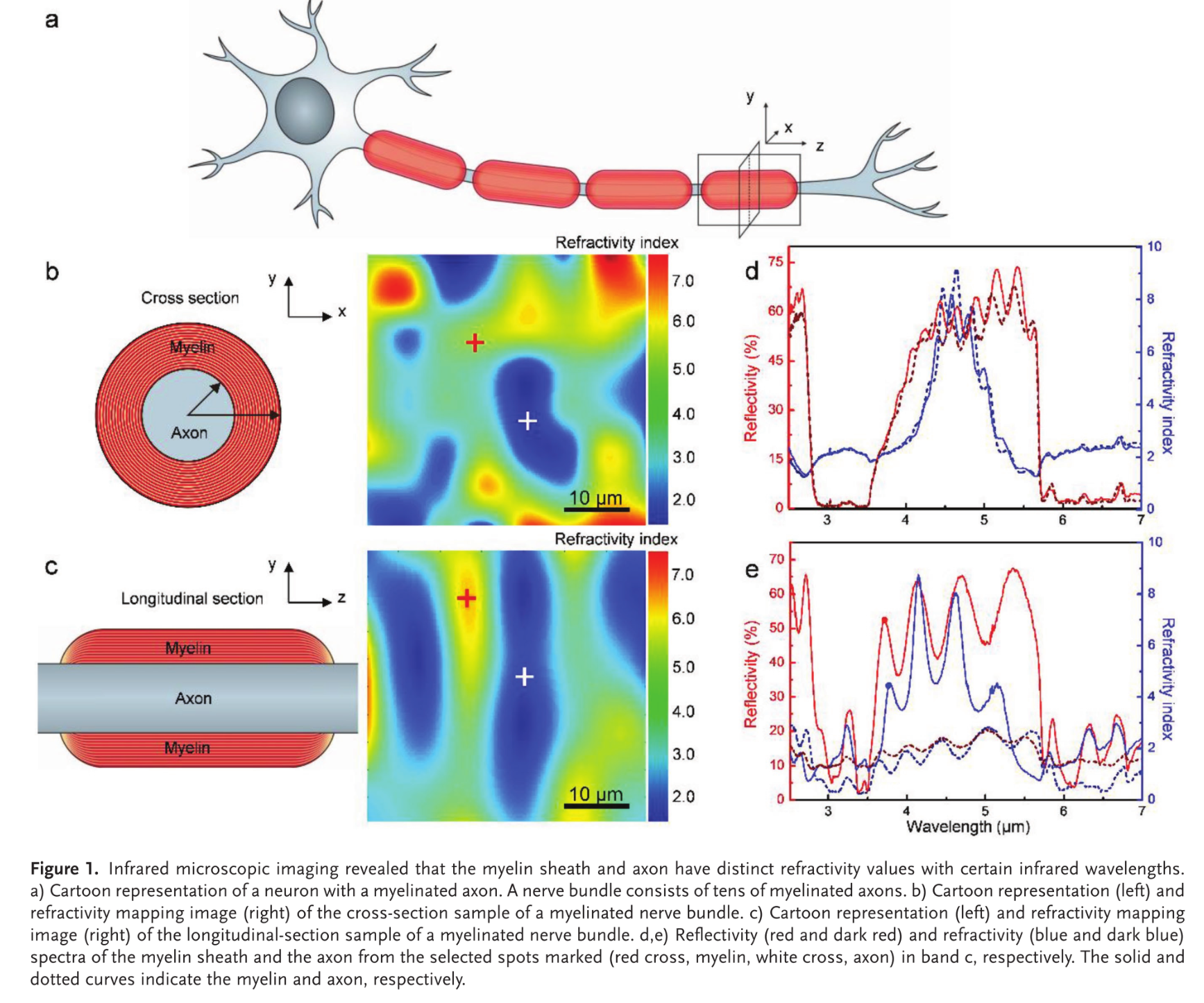Carlos's Home Page
Just Bloggin'
Myelin as a Waveguide
Posted on
Recently I’ve been reading a lot of neuroscience and materials papers to come up with a research proposal. I stumbled across a paper [1] from a lab that did spectroscopy on cultured neurons. They showed that myelin has a high refractive index in the infrared band, which is consistent with dialectric properties in that band. They specifically call out the peak refraction index at about 5 micron wavelength.So, 60 THz.

Myelin is a material that grows around the axon of a neuron. The brain’s myelin factories are called oligodendrocytes. They build the myelin sheath, which conformally coats the axon except for certain areas called “Nodes of Ranvier”. Neurons communicate with each other by firing action potentials, which are electrical signals that start at the cell body and propagate to the next neuron. At least, this is my very basic understanding of it.
Also, myelin production can break down. This is the principle mechanism of several diseases, one of which is Multiple Sclerosis. When myelin production stops, the conduction velocity of the axon decreases and action potential propagation slows.The common explanation for this, which I think is a good one, is that myelination decreases the capacitance of the axon. There are a couple of models – a single cable model, and a double cable model which is more precise [2].

I have spent almost no time studying optics or terahertz waves, so for me the idea that neurons could be signaling each other at those frequencies sounds esoteric, at best. I just don’t know anything about it. One thing that occurred to me is that a wave propagating through the sheath could excite a current at the dialectric interface. Would that increase the conduction velocity? I think it depends on the propagation mode, which… can that even be known? Myelin is, presumably, surrounded by conductive material – both the axon, and the extracellular soup. As far as waveguides go, the most similar geometry that I have studied is the rectangular waveguide. I believe that in this case, a tangential magnetic field can excite a surface current at the boundary, but I need to review the rectangular waveguide. Even if it did, how does surface current at the boundary change the conduction velocity of the axon?
I don’t know enough about optics to evaluate the claim that myelin could be transmitting near-infrared signals. Presumably, myelin would be transmitting these signals between the Nodes of Ranvier. So what happens when the signal gets to the next node? It just dissipates? I think the researchers addressed this in their paper, so I will have to review their thoughts on it.
Another issue that bothers me is the heat. Doesn’t this damage stuff? There are many other complications.
The project I’m proposing is to develop a microfluidic platform to test some of this, but I still have to decide what parameters to vary and measure. The basic idea of the platform is to have two chambers with micro-channels running between them, and somehow getting the neurons in there so that their axons extend longitudinally through the micro-channels. I have seen this type of thing before [3]. Then, I need to stim the neurons with (I guess) a 5-micron wavelength pulsed beam. I think that if the myelin is acting as a dialectric, then I should be able to measure the light in the output chamber. The problem with this is that how do I know it isn’t just propagating through the extracellular region? A filter won’t work, since the axons have to extend through the channel. I wonder if the geometry of the channel can be designed so as to dampen that wavelength.
Then’s there’s all the instrumentation concerns. How do I generate/measure a pulse beam of that size and wavelength? I have no idea.
A secondary thing, is that I still kind of like the idea that the conduction velocity of a neuron could be modulated by infrared waves in the myelin. It would be cool to put multiple electrodes through the length of the micro-channel to measure the conduction velocity, as well.
[1] G. Liu et al., “Myelin Sheath as a Dielectric Waveguide for Signal Propagation in the Mid-Infrared to Terahertz Spectral Range,” Advanced Functional Materials, vol. 29, no. 7, p. 1807862, 2019, doi: 10.1002/adfm.201807862.
[2] C. C. H. Cohen et al., “Saltatory Conduction along Myelinated Axons Involves a Periaxonal Nanocircuit,” Cell, vol. 180, no. 2, pp. 311-322.e15, Jan. 2020, doi: 10.1016/j.cell.2019.11.039.
[3] B. E. Kerman et al., “In vitro myelin formation using embryonic stem cells,” Development, vol. 142, no. 12, pp. 2213–2225, Jun. 2015, doi: 10.1242/dev.116517.